(Strand)om Stories: Daredevil Epic Collection: It Comes With the Claws Review
Multiple creators struggle, one more successfully than others, to reshape Matt Murdock's new life in the wake of Frank Miller
—by Nathan on February 11, 2025—
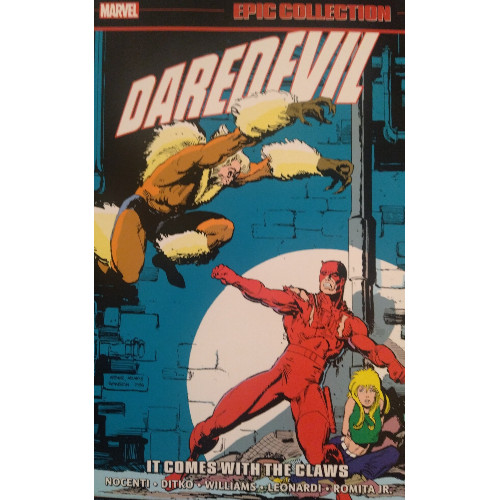
How do you follow an act like Frank Miller's Daredevil?
Once the devil had been born again, Miller left the book to craft the future of DC's Dark Knight Detective as well as redefine his past. Miller had left a deep impression on the Man Without Fear, not only rocking his world through the machinations of the Kingpin during "Born Again" but elevating the character outside his paneled pages. Prior to Miller's original run, Daredevil slogged through the comic scene, published on a bi-monthly basis. Miller (with help from Roger McKenzie) revitalized the book with his noir sensibilities, popularizing his ninja assassin Elektra (to the point he received death threats after killing her off) and creating in Daredevil a rival to the best-selling comics of the era, Marvel's Uncanny X-Men and DC's New Teen Titans.
And then he slipped into the night, like his fan-favorite ninja assassin.
Imagine being Marvel's editorial team at that moment. Frank Miller has just returned to the book he massively popularized to craft a well-received arc as a capstone to what he wrote before…and then he's gone. Hence my question above. What do you do?
The answer, as we shall see, is not as simple as this reader imagined.
Daredevil Epic Collection: It Comes With the Claws
Writers: Mark Gruenwald, Danny Fingeroth, Ann Nocenti, Steve Englehart (as John Harkness), Christopher Priest (as Jim Owsley)
Pencilers: Steve Ditko, Barry Windsor-Smith, Louis Williams, Sal Buscema, Todd McFarlane, Keith Pollard, Chuck Patton, Tom Morgan, Keith Giffen, Rick Leonardi, and John Romita Jr.
Inkers: Klaus Janson, Danny Bulanadi, Al Williamson, Steve Leialoha, Al Milgrom, Tony DeZunga, Dave Hunt, Barry Windsor-Smith, Bob Wiacek, Geoff Isherwood
Colorists: Christie Scheele, Petra Scotese, Bob Sharen, Paul Becton, George Roussos
Letterers: Joe Rosen, Janice Chang
Issues Collected: Daredevil #234-252
Volume Publication Date: November 2022
Issue Publication Dates: September 1986-March 1988
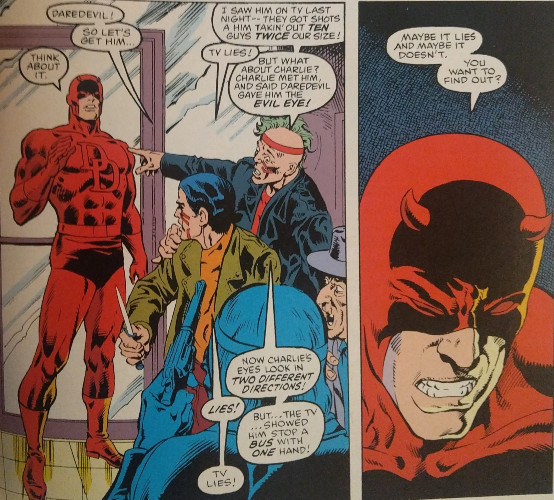
The Daredevil issue immediately following the end of Miller's "Born Again" arc indicates a certain listlessness at Marvel as they struggled to determine the future of their blind-attorney-turned-vigilante. A chunk of this volume–basically, the first four issues, or about the first hundred pages–feel simultaneously beholden to what Miller had developed and hopeful that a new tone could enter the adventures of the Man Without Fear. Gone are the ninjas and demons, absent is the imposing mob boss who tore Matt Murdock's life asunder, little to no reference is even made to Elektra or Stick. With the Kingpin dismantling Daredevil's life during "Born Again"–blowing up his apartment, causing him to lose his lawyer's license, beating Murdock within in an inch of his life–the devil of Hell's Kitchen wants things to be different. He wants a clean slate, a chance to start over. And it seems Marvel, with a touch of meta commentary, wanted the same. The era of Miller was over, so why not try something new?
Tonally, these first few issues are a far cry from what Miller developed, and the shift in tone is wild if you're reading from one story to the next. A narrative which ends with Matt's life torn asunder leads into a story about a seemingly un-killable vigilante courtesy of Mark Gruenwald and, of all the artists you could choose, Steve Ditko. I'm not knocking Ditko–the man is a legend for a reason–but artistically, the book's sudden shift from grit to lighter fare is noticeable and somewhat distracting. Much as I enjoy Mark Gruenwald, and as clever as his script is (and as much as I respect Steve Ditko), the issue feels out of place in the little corner Miller had created for Daredevil in Hell's Kitchen.
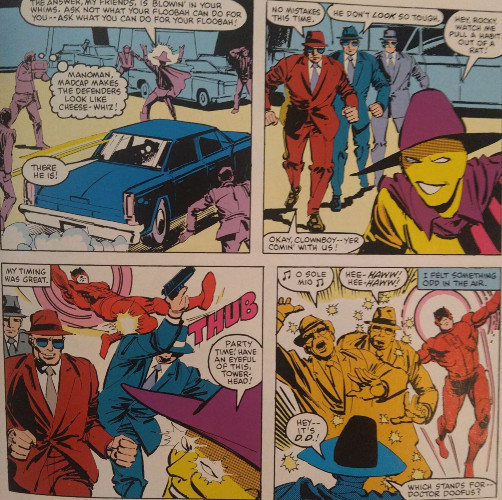
Certain details feel a little glossed over, as if these early post-Miller issues set us a few months past the events of "Born Again" without ever completely rationalizing how we reached this point. Matt is officially dating Karen Page, works at a diner flipping burgers, and has even largely abandoned the "blind person" disguise he wore with glasses and a cane. Gone is the desire to continue working as a lawyer or even attempting to regain his license. Matt claims he's happy, but these first few issues don't do enough to alert the reader as to whether he's faking happiness or if he's genuinely content and hoping the reader will feel the same way. Casting us into a different status quo immediately following Miller's arc creates a disconnect, and as a result, these first few issues are a struggle. The "moving on" aspect from "Born Again" would make for an engaging narrative, to watch Matt and Karen pick up the pieces. But we're left to believe they already have, that they're happy, that Matt has moved on. We don't see the struggle he endures in reshaping his life, and thus the happiness isn't wholly deserved.
I don't mean to say writers can't have fun with Daredevil as a rule or that the title must always plumb the deepest darknesses of human experience. Mark Waid and Chris Samnee's run is incredibly fun, vibrant in its artistry. Matt can enjoy being Daredevil, but here, the tone change feels abrupt, jarring, too much of a shift to consider seriously. It lacks subtlety. You'd have to be, well, blind to not notice the jump. Marvel seemed hesitant to even directly acknowledge the events of "Born Again," for whatever reason. We are given references to that story arc but not much in the way of a direct movement from one to the other. Heck, we're probably reminded of Daredevil's origin and powers more frequently!
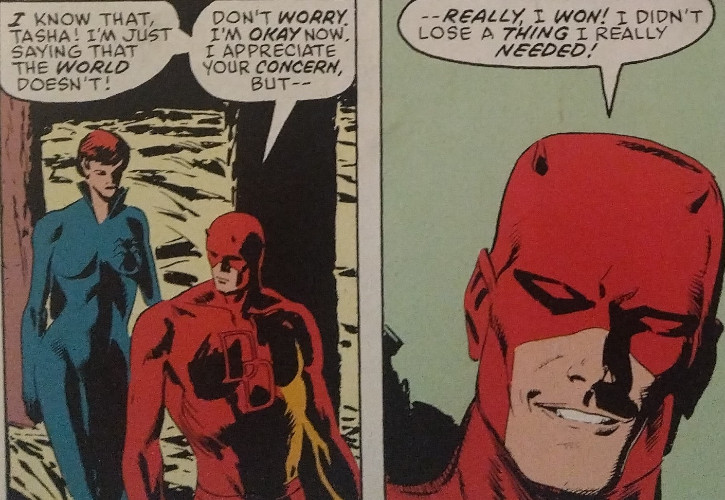
There is, admittedly, a thematic notion woven throughout the narrative, even extending into Ann Nocenti's run, the first issues of which are collected here. Though Matt has seemingly put together most of the physical pieces of his life already, he wrestles with who he is internally. Encountering Klaw in a Steve Englehart-written issue, Daredevil balks at being called "small-time." In Nocenti's first issue, he tells the Black Widow he's doing great and doesn't need anything, marking the first time a writer indicates he's intentionally putting on a bit of an act and not as wholly healed from his previous crisis as he hopes others believe.
Perhaps as a pushback against the violence Miller inundated his run with, Daredevil encounters a few folks who chastise him for his brutality–does he always need to solve problems with his fists? How can the people of Hell's Kitchen feel protected by a man who's idea of "defense" is to leave criminals beaten and bloodied at the police station? Even Karen tries to draw a distinction between Matt and Daredevil–she doesn't want his gloves to touch her, knowing they've been used for violence. She wants Matt, not Daredevil.
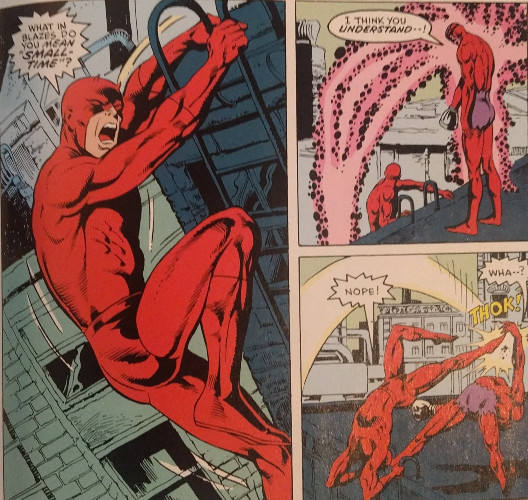
The idea of who Matt and Daredevil are, as both separate individuals and as one man, are being redefined, much the same way Miller changed who the character was. Under Miller, Daredevil embraced a deeper darkness inherent in the concept of the character but never commented on directly. Here, Nocenti (and, to an extent, the other writers) are trying to juggle Matt with a seemingly new lease on life who still retains some of the attitudes and outlooks of the Miller era Daredevil. It is simultaneously an homage to what has come before–or, at least, an attempt to maintain some kind of status quo left over from Miller–and an opportunity to begin a bit new, lay the groundwork for future stories. Where the writers, except for Nocenti, fail is instituting that shift too quickly and too fiercely. If Matt Murdock is to crawl out of the darkness, it must be inch by inch through a tunnel into a slowly rising sun, not as an instant burst into the light of a new day.
Nocenti, when she takes over, doesn't backtrack or detract from what Gruenwald, Fingeroth, and Englehart have done; instead, she looks at the sunlight into which other writers have thrust Matt into and lets a few clouds roll in. She tempers the joyful thrill of Matt's new beginning. He and Karen still date–a more than acceptable change in the status quo, I'll add, given the hell Miller put the couple through–but conflict seeps into their relationship, altered from the rose-colored lenses through which they saw each other under the other writers. Nocenti moves Matt away from the absolutely bizarre choice of flipping burgers for a living and begins the hard work of moving him back into handling matters of law. To her credit, she even uses a few issues to serve as "postscripts" to "Born Again," epilogues which expound on ideas Miller introduced in that narrative in clever, unexpected ways.
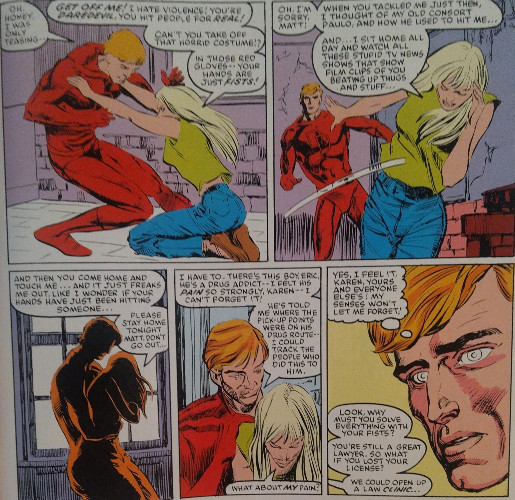
Several of her stories are "one and done" issues, with a few two-parters thrown in for good measure. Much like how Nocenti shifts Matt into this new phase of his life, so the title itself is being prepared for grander stories. As these stories are coming off the epic that is "Born Again," I don’t discount writers developing a few intermediary issues between arcs (and, as far as I'm aware, the next "big" Daredevil arc begins in the next Epic Collection, which I also hope to review down the line), and I think Nocenti is wise to toy with a few smaller narratives before launching into a longer, more complex story. Having recently reviewed a Spider-Man narrative where I felt Nocenti attempted too much in a much smaller space, I'm grateful of the time she takes to develop her sense of Daredevil...no radar needed.
Artistically, we are all over the place here. I already mentioned Steve Ditko's contributions, and though it's nice to see his style evolved over twenty years, his work feels tonally awkward, particularly as the issues he illustrates feature lighter fare better attuned to Ditko's Silver Age sensibilities with some darker material the famed artist can't quite pull off. Barry Windsor-Smith brings his detailed pencils to one of those "Born Again" epilogue issues, providing the necessary emotions and action-oriented panels to create a proper follow-up to Daredevil's climactic battle with Nuke; Keith Giffen, whose work I've appreciated on Justice League and Legion of Super Heroes, offers a surprisingly modern look to the other follow-up issue. And the ever-talented John Romita Jr. graces the final issues, forming the bedrock upon which he'd construct a strong collaboration with Nocenti. Perhaps it's my familiarity with and fondness for Romita Jr.'s work (including a fantastic collaboration with Miller in the 90s) which allows me to sink into a more pleasant reading experience. I like Ditko, and I certainly enjoy Windsor-Smith, but Romita Jr. is right alongside Tim Sale as one of the topmost of top-tier comic artists in my opinion, a stalwart favorite.
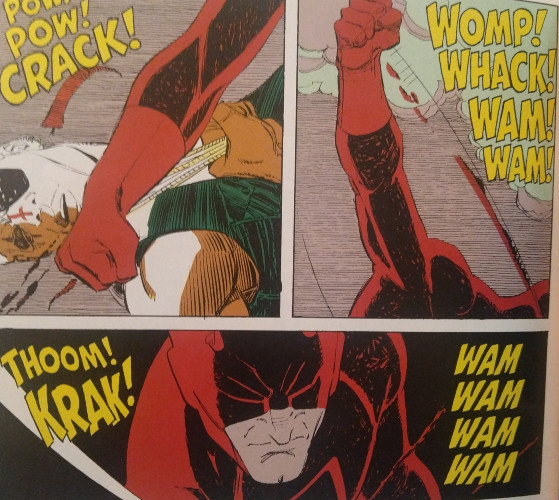
It Comes With the Claws struggles to find its footing, walking more confidently the deeper we get into the Nocenti-penned issues. It must have been a lot to ask writers and artists to follow the work of a writer considered one of the greatest contributors to Daredevil's mythos who had just finished his most enduring chapter on the character. Nocenti is a breakout star in these pages, and I feel encouraged to give more of her run a read in the future. Matt Murdock had previously been "Born Again," and we get him taking his first, halting steps in the wake of that rebirth. Perhaps that's how we can justify some of the shakier stories and concepts delivered here.